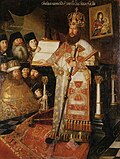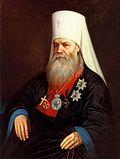Top Qs
Timeline
Chat
Perspective
List of metropolitans and patriarchs of Moscow
From Wikipedia, the free encyclopedia
Remove ads
This article lists the metropolitans and patriarchs of Moscow, spiritual heads of the Russian Orthodox Church. Since 1308, there have been 59.
You can help expand this article with text translated from the corresponding article in Russian. (August 2016) Click [show] for important translation instructions.
|
 |
 |
Remove ads
History
The Russian Orthodox Church traces its beginnings to the Christianization of Kievan Rus' at Kiev in 988 AD. In 1316 the Metropolitan of Kiev changed his see to the city of Vladimir, and in 1322 moved again to Moscow. In 1589, the see was elevated to a Patriarchate. The Patriarchate was abolished by the Church reform of Peter the Great in 1721 and replaced by the Most Holy Governing Synod, and the Bishop of Moscow came to be called a Metropolitan again. The Patriarchate was restored by the 1917–18 Local Council and suspended by the Soviet government in 1925. It was reintroduced for the last time by the 1943 Bishops' Council, during World War II by the initiative of Soviet leader Joseph Stalin. To this date, 19 of the Metropolitans have been glorified in the Russian Orthodox Church.
Remove ads
Metropolitans of Kiev and all Rus' (permanent residence in Moscow, 1325–1441)
Summarize
Perspective
For a list of metropolitans before the seat of the Metropolis of Kiev and all Rus' was moved to Moscow, see List of metropolitans and patriarchs of Kyiv.

Isidore of Kiev, who was of Greek origin, submitted to the articles of the Bull of Union with the Greeks which united the Orthodox Church in Russia with the Latin Church. Following his acceptance of the Council of Florence, Isidore returned to Moscow in 1441 as a Ruthenian cardinal. He was arrested by the Grand Prince of Moscow — Vasily II, and accused of apostasy. The Grand Duke deposed Isidore and in 1448 installed his own candidate as Metropolitan of Kiev — Jonah. This was carried out without the approval of Patriarch Gregory III of Constantinople. When Isidore died in 1458, the Orthodox dioceses within the territory of the Grand Duchy of Lithuania, including Kiev, were reorganized. The metropolitan see was moved to Vilnius, the capital of the Grand Duchy of Lithuania. A parallel succession to the title ensued between Moscow and Vilnius.
Remove ads
Metropolitans of Moscow and all Rus' (1448–1589)
Summarize
Perspective
The Grand Prince of Moscow voided the Union of Florence and imprisoned Metropolitan Isidore for some time. Following that incident, the Grand Prince removed Isidore from office and appointed his own man — Jonah. These decisions were not recognised by Patriarch Gregory III of Constantinople who continued to recognise Isidore as the canonical metropolitan. As a result, in 1448, Jonah unilaterally changed his title to "Metropolitan of Moscow and all Rus' " which was tantamount to a declaration of independence of the Church in eastern Rus' from the Patriarchate of Constantinople. All sixteen successive hierarchs of the Metropolis of Moscow and all Rus' were selected by the civil power and installed without the approval of the Patriarchate of Constantinople. Successive patriarchs continued to recognize Isidore and his successors as hierarchs of the Metropolis of Kiev and all Rus'.
Remove ads
Patriarchs of Moscow and all Rus' (1589–1721)

Remove ads
Metropolitans and archbishops of Moscow (1721–1917)
Remove ads
Patriarchs of Moscow and all Rus' (restored, 1917–present)
Remove ads
Timeline of patriarchs

See also
References
Wikiwand - on
Seamless Wikipedia browsing. On steroids.
Remove ads



















































